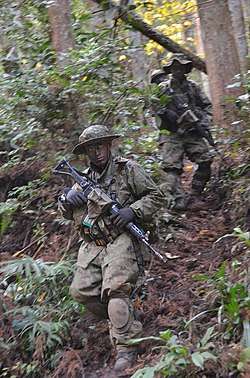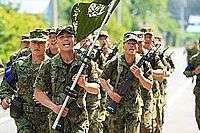Ranger Courses (Japan Ground Self-Defense Force)
Ranger Courses (レンジャー課程, Renjā-katei) of the Japan Ground Self-Defense Force (JGSDF) are military training courses oriented toward Commando operations.[1][Note 1]
| Rangers | |
|---|---|
| レンジャー | |
.jpg) Ranger pin badge as used in the JSDF. | |
| Active | 1956–present |
| Country | |
| Branch | |
| Type | Special Forces-type training courses |
| Role | Special operations Direct Action Airborne assault Unconventional Warfare Reconnaissance |
| Garrison/HQ | Fuji Training School, JGSDF Camp Fuji |
| Insignia | |
| Identification symbol | Ranger Pin Badge |
Background
The original course that is being held at Fuji School was established in 1956 by two JGSDF officers who had graduated from the United States Army Ranger School.[2] This course was basically the Japanese version of the American Ranger School at the beginning.[2]
As ranger courses continue to be carried out in various JGSDF units, they developed according to the country's geography.[1]
Ranger Courses

Generally, there are four types of Ranger Courses as follows, but all courses are known for their severe harshness so only eligible soldiers can take these courses:[Note 1]
- Local courses
- Enlisted ranks can take Ranger courses with their divisions, brigades and regiments. These courses are conducted by instructors who have completed the Fuji School course, but are localized according to the area in charge of each unit.[1] For example, there is the Japanese Alps in the area of responsibility for the 13th Infantry Regiment (Matsumoto, Nagano), so its Ranger Courses focus on mountain warfare and are known as the "Alpen Ranger".[3]
- After heavy physical training, nine exercises are held in the ordinary local course for nine weeks while enduring great mental and psychological stresses and physical fatigue, and the following skills are acquired:[1]
- Navigation
- Demolition
- Military communications
- Waterborne infiltration
- Air assault
- Survival skills
- Mountaineering skills
- Special reconnaissance
- At the Fuji School (at the base of Mount Fuji)
- Course instructor candidates and officers need to complete the 13-week course at the Fuji School.[4]
- At Narashino (Chiba Prefecture)
- The 1st Airborne Brigade aims to give ranger training to all the members and implements its own Airborne Ranger Courses.[5]
- At Niseko (Hokkaido)
- The Winter Ranger Course (冬季遊撃課程, Tōki-Yūgeki-katei) is established by the Cold Weather Combat Training Unit (冬季戦技教育隊, Tōki Sengi Kyōiku-tai). This is advanced post-graduate ranger training for cold-weather warfare, thus soldiers who have completed this course are entitled to wear special badges, in addition to regular ranger badges.[6]
JGSDF soldiers are not the only to participate in the courses. Air Self Defense Force paramedics (Japanese counterpart of the United States Air Force Pararescuemen) also have participated in various ranger courses. JGSDF rangers are known as the pioneers of the rope and mountain rescue techniques, thus eligible members of the civilian law enforcement and rescue organization (Mountain security squads of the Police and Rescue Technicians of the Fire departments,[Note 2] for example) can take Ranger Courses arranged for search and rescue operations.[7][8]
- Scenes of local courses
 Physical training: 10-mile run with the Ranger flag in the lead
Physical training: 10-mile run with the Ranger flag in the lead_R_%E6%95%99%E8%82%B2%E8%A8%93%E7%B7%B4%E7%AD%89_116.jpg) Waterborne infiltration by an inflatable boat
Waterborne infiltration by an inflatable boat Air assault: rappelling from a Bell-Fuji UH-1J
Air assault: rappelling from a Bell-Fuji UH-1J_R_%E6%95%99%E8%82%B2%E8%A8%93%E7%B7%B4%E7%AD%89_258.jpg) "Alpen Ranger" course
"Alpen Ranger" course Marching at the end of the final exercise while other soldiers cheer them on.
Marching at the end of the final exercise while other soldiers cheer them on. Return of the Ranger flag in the completion ceremony
Return of the Ranger flag in the completion ceremony
Deployment
Unlike the United States Army Rangers, the JGSDF has adopted a policy to improve the level of the whole forces by distributing rangers to each units, thus the unit consisting only of rangers was not established except for the training units in the Fuji School and CWCT. But in case of special operations or disaster response, commanding officers may gather Rangers and organize Ranger units temporarily.[1]
When the Western Army Infantry Regiment (WAiR; later expanded to the Amphibious Rapid Deployment Brigade) was launched in 2002, Ranger platoons were set up in this regiment. These platoons are certified as special operation units.[9] In 2012, they conducted joint landing exercises with the United States Marine Corps in Guam.[10][11]
Notes
- As official names, Fuji Courses, Airborne Ranger Courses and the Winter Ranger Course are distinguished as Katei-kyōiku (課程教育) officially recognized by the Ground Staff Office, and local courses are Shūgo-kyōiku (集合教育) of each units own.
- They're known as Super Rangers in English literature in Japan with various fire departments/bureaus.
References
- Tani 1988, pp. 124-153.
- Tani 1988, pp. 29-44.
- North Kanto Defense Bureau, ed. (2016). "Featured! Ground Self Defense Force 13th Infantry Regiment" (PDF). Retrieved 2018-07-22.
- Tani 1988, pp. 45-60.
- Tani 1988, pp. 93-123.
- Tani 1988, pp. 154-186.
- Defense Agency, ed. (1993). "Chapter 4. The Self-Defense Force in society". White paper for defense. Ministry of Finance Printing Bureau.
- Foreign Press Center Japan (November 7, 2014). "Notice: Yokohama Press Tour "Behind the Scenes of Disaster Rescue Initiatives in the Birthplace of Rescue Teams in Japan"". Retrieved June 18, 2019.
- Shigeru Ishiba (2004). "Instruction concerning the scope of special operation members" (PDF). Retrieved 2018-08-09.
- Hardy, James (January 21, 2013). "Japan's Navy: Sailing Towards the Future". The Diplomat.
- "First joint training in the island - The Ground Self Defense Force and the 3rd Marine Corps of the United States". The SDF news. October 15, 2012.
Books
- Tani, Saburō (1988). レインジャー―陸上自衛隊最強の戦闘員 [Rangers - The Strongest Combatants of the Ground Self Defense Force] (in Japanese). Fusosha Publishing. ISBN 978-4594002350.CS1 maint: ref=harv (link)
External links
![]()